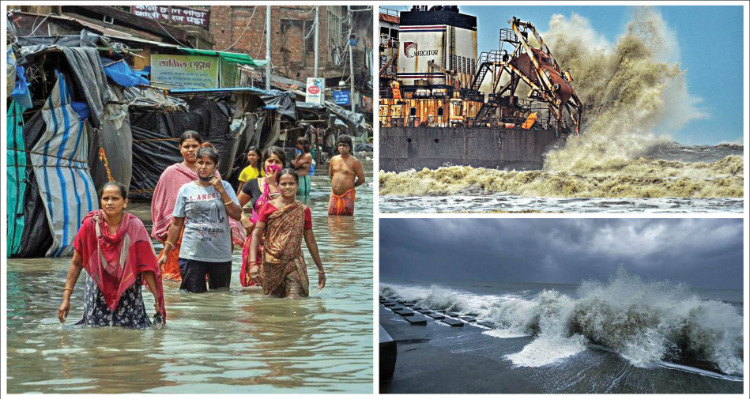Outstripping menace
More frequent and intense tropical storms are creating an urge for organised preparedness and greater awareness to withstand such disasters

Cyclone Tauktae and Yaas, sweeping in from the Arabian sea on May 14 and the Bay of Bengal on May 26 respectively left a trail of destruction behind them. Apart from causing widespread damage to infrastructure and agricultural land, the storms have killed and displaced many people along the western and eastern coasts. The effect of the cyclones becomes even more pronounced in the wake of a pandemic. As these cyclones throw flashbacks of the 2018 cyclone Amphan, people are looking for causes.
Amphan was supercharged by gathering energy from the anomalously high sea surface temperatures in the Bay of Bengal. Just about a week after Amphan, cyclone Nisarga formed over the Arabian Sea and struck the Maharashtra coast. In the post-monsoon season, cyclone Nivar hit the Coromandel coast at Puducherry.
Tropical cyclones can have devastating economic consequences. Globally, they are among the most destructive natural hazards. From 1980 to 2018, tropical cyclones accounted for nearly half of all the natural disaster losses worldwide, with damage amounting to an aggregate of USD 2,111 billion. The vulnerability to cyclones has been further increased due to factors including population growth, urbanization, increased coastal settlement, deforestation, destruction of mangrove forests and global warming. Also, non-compliance with Coastal Regulation Zone notification is one of the causes.
A tropical cyclone is an intense circular storm that originates over warm tropical oceans and is characterised by low atmospheric pressure and strong winds followed by heavy rainfall. Tropical cyclones always have an eye, a central region of clear skies and warm temperatures. The influence of climate change on TCs has been notoriously difficult to separate from natural variability. But an increasingly consistent picture is emerging that suggests human activities are probably influencing some aspects of these extreme weather events, although the exact extent of the human influence is still difficult to determine. Many of the observed trends in TCs are at least qualitatively consistent with predictions based on the warming climate. if the globe warms by two degree Celsius, it will cause roughly a five per cent increase in maximum wind speeds.
Since satellite records began in India in 1980, this is the first time that pre-monsoon cyclones have been recorded in the Arabian Sea for four consecutive years. It is now a well-known fact that the global ocean has absorbed 90 per cent of the excess heat generated by greenhouse gas (GHG) emissions since 1970. This has led to anomalous ocean warming, making cyclones intensify rapidly. This proportion of intense TCs is projected to increase further.
According to researchers, cyclones are also intensifying so rapidly because of unprecedented high temperatures over the Indian Ocean. It is explained in the way that heat is energy, and cyclones intensify rapidly by turning the potential energy stored in the ocean to kinetic energy. The energy of a cyclone is proportional to the mass of the air and its velocity squared. An index of cyclone energy, known as the Accumulated Cyclone Energy has been developed. Tropical storms are caused by rising warm moist air over the seas. As the air rises it draws in more warm air feeding the storm. As the hot air rises it also cools and condenses. When it condenses it gives up the latent heat of vapourisation which gives more energy to the storm. When storms reach land, or cold water, they lose energy due to friction and also because warm, moist air supply from the oceans is cut off. The western tropical Indian Ocean has been warming for more than a century, at a rate faster than any other region of the tropical oceans, and turns out to be the largest contributor to the rising trend in the global mean sea surface temperature (SST).
A panel comprising 13 countries, including India, Bangladesh, Myanmar, Pakistan, the Maldives, Oman, Sri Lanka, Thailand, Iran, Qatar, Saudi Arabia, the United Arab Emirates and Yemen, name cyclones in the region. In 2020, a new list of names was released that had 169 names of cyclones, having 13 suggested names each from 13 countries. 'Tauktae' (pronounced Tau'Te) was named by Myanmar. In the Burmese language, it means a 'gecko' or a very hitch-pitched lizard. 'Yaas', on other hand, was named by Oman, meaning Jasmine in English. The next one will be called 'Gulab'. as proposed by Pakistan.
In this piquant situation, there is an emergent need to identify the most vulnerable areas of our nation and prepare a national policy with international support for implementation. The nation must provide specific goals with deadlines. Actions to be implemented include reforestation, preparing local emergency shelters, building of levees and dams, creation of early warning systems, reinforcing existing communication infrastructure, finding new sources of freshwater, promoting and subsidizing the proliferation of renewable energy, improving irrigation techniques to promote sustainable agriculture, increasing public education efforts on sustainable measures, and lobbying internationally for the increased use of renewable energy sources. In addition to these, some ecosystems, such as marshes, mangroves, and coral reefs, must be preserved as these serve as a natural prevention against coastal erosion, storm surges, and wind damage caused by hurricanes. These natural habitats serve as a carbon sink and support the biodiversity of the particular region. Although there is substantial evidence of natural habitats being the more beneficial barrier for tropical cyclones, built defences are often the primary solution.
If the people of the coastal and mangrove areas were more aware of the ocean vulnerability and ecological fragility of their coastal home, they would surely ensure greater compliance with the laws and regulations.
The writer is a former Senior Scientist, Central Pollution Control Board. Views expressed are personal



